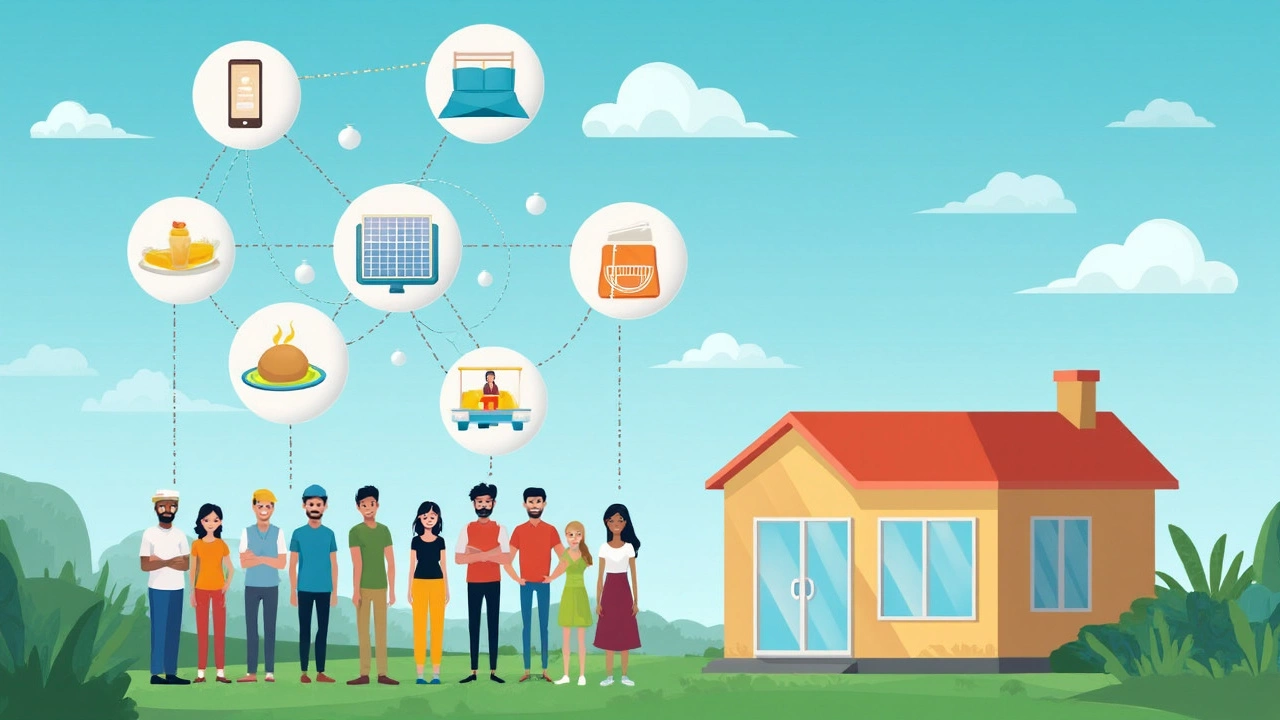Ever come across the term “smart grant” and wondered what makes it different from regular grants? It’s not just a catchy label—smart grants are shaking up how homeless shelters get the support they need. Think of a smart grant as funding with brains behind it. Instead of just handing out money, these grants are usually tied to actual results and creative ideas.
Smart grants focus on projects that use data, new technology, or clever teamwork to improve life for people who need shelter. For example, some smart grants ask shelters to show how their plan will help more people find stable homes fast, or monitor what works so everyone can learn and improve. If you’re part of a shelter, paying attention to smart grants can open doors to more than money—think training, partnerships, and tools that make a difference day-to-day.
Let’s get practical: most smart grants give clear checklists—what you need to qualify, what counts as “success,” and even connections to groups willing to help you out along the way. This is a game-changer if your shelter has great ideas but not a huge budget. You don’t have to be a tech wizard either; as long as you’re open to testing something new or tracking outcomes, you could be in line for a big boost.
- What is a Smart Grant, Really?
- How Smart Grants Work for Shelters
- Benefits That Go Beyond Money
- Tips for Winning a Smart Grant
- Smart Grants in Action: Real-World Results
What is a Smart Grant, Really?
A smart grant is a different kind of funding offer for homeless shelters. Unlike regular grants that just hand over money, smart grants usually come with strings attached—specifically, they want you to show results. The real point here is to encourage fresh ideas, smart tech, or new ways of solving old problems for people who are homeless.
Most smart grant programs have three things in common:
- They make you set measurable goals upfront—like helping a certain number of people find stable housing or tracking the impact of a new service.
- They reward shelters for using solid data and sometimes even tech tools, maybe a case management app or a simple tracking spreadsheet, to prove what’s working.
- They offer more than just money. Some will hook you up with experts or ongoing advice so your project gets farther than it would with cash alone.
Sounds complicated? It’s actually simpler than you think. For example, a city government might launch a smart grant just for shelters that can lower the number of nights people spend without housing. Or a private group could focus on funding your shelter, if you’ll roll out something like a text message alert for available beds. The big picture: smart grants want to see clear, trackable progress.
Here’s a snapshot of some common traits smart grants share:
| Feature | Why It Matters |
|---|---|
| Outcomes-based funding | You get funded for results, not just plans. |
| Focus on data or tech | Applicants often use tools/software to track progress. |
| Extra support | Expert advice or training alongside money. |
So, if you run or support a homeless shelter, and you’ve got a project idea with real goals and a method for tracking what you do, a smart grant could be a perfect fit. It’s not just about the money—it’s about building something that actually makes a difference, and having the proof to back it up.
How Smart Grants Work for Shelters
So how do smart grants actually work for homeless shelters? Basically, these grants ask shelters to go beyond simply providing beds. The money comes with a goal: show what works, then share those results. It’s about getting creative, using data, and making every dollar count. Shelters are encouraged to try out tech, like tracking systems that help keep tabs on who needs what, or platforms that match people with job training or housing faster. Don’t worry—you don’t need a team of coders. Sometimes, all it takes is using a shared database or app to help with daily check-ins or collecting feedback from guests.
Most funders giving out smart grants want shelters to do a few things:
- Write up a plan that targets a specific problem, like cutting waiting times or helping guests stay housed after leaving the shelter.
- Test a new idea or tool, then track what actually happens. Maybe that’s a new case management system or a mental health screening process.
- Share stats and stories, so everyone can see what worked and what didn’t. This isn’t about blame—it’s about learning.
- Team up with other groups. Often, the best results happen when shelters, clinics, or city offices join forces and pool resources.
Here’s a look at what you might see in a typical smart grant application process:
- Find a grant (tip: sites like Grants.gov and the HUD Exchange are good places to look).
- Propose a solution—a tech upgrade, pilot program, or partnership that solves a real challenge in your shelter.
- Lay out the details. Funders want to know your plan, team, what success will look like, and how you’ll track results.
- Get approved and start your project, including regular check-ins and progress reports.
If you’re wondering if this approach works, here’s a simple table showing the kind of change shelters have reported after receiving smart grant funding:
| Aim | Before Smart Grant | After Smart Grant |
|---|---|---|
| Average days to find housing for guests | 63 | 31 |
| Staff time spent on paperwork (hrs/week) | 15 | 6 |
| Guests accessing job training (%) | 22% | 60% |
Bottom line: smart grants for homeless shelters reward fresh ideas, teamwork, and keeping track of what really helps. If your shelter is open to trying new things and telling your story, you’ll fit right in.

Benefits That Go Beyond Money
A smart grant does more than just fill up a shelter’s bank account. Sure, extra cash is great, but what really sets these grants apart is how they change the game for shelters and the people they serve. Let’s dig into what actually comes with a smart grant, besides the obvious dollars and cents.
When shelters win a smart grant, they often get fresh tools or training that make daily work smoother. For example, a 2023 report from the National Alliance to End Homelessness found that shelters using grant-funded case management software reduced client wait times by 40% in just six months. That means less paperwork getting in the way of real help.
- Access to technology: Some smart grants pay for things like online intake systems, apps for tracking resources, or even data analysis software. This bumps up efficiency—and shelters can help more people, faster.
- Better training: Many grants include workshops on topics like trauma-informed care or using new tech. These aren’t just check-the-box classes; they actually give staff the know-how to respond better during high-stress times.
- Ongoing support: It’s not “take the money and run.” Grant providers often offer check-ins, advice sessions, or feedback so shelters don’t feel lost and can tweak what isn’t working.
- Peer collaboration: Some smart grants hook shelters into a bigger network. Picture regular calls or meet-ups with other shelters tackling similar challenges. Shelters swap ideas, share short-cuts, and help each other avoid mistakes.
- Measurable impact: Smart grants encourage shelters to set clear goals and track what really works. This isn’t just busywork—the data helps prove success and secure more funding down the road.
If you’re wondering what kind of changes actually show up, check out this quick view:
| Benefit | Reported Improvement* |
|---|---|
| Case tracking technology | Up to 50% faster case resolutions |
| Staff training on new systems | 30% higher client satisfaction |
| Peer collaboration | 15% drop in repeat homelessness |
* Data from a 2023 survey of 40 U.S. shelters using smart grants
The bottom line? Homeless shelters that land smart grants walk away with more than money—they get a leg up on making real change, building a team that’s ready for anything, and connecting to people and tech that keep them ahead of the curve.
Tips for Winning a Smart Grant
If you want your homeless shelter to snag a smart grant, you’ll need more than just a wish and a well-meaning idea. Funders want to see clear plans, real results, and why your approach is worth backing over others. Here’s how shelters like yours can actually stand out in the grant game.
- Get the Basics Right: Read the grant rules—twice. Shelters miss out just because of missing paperwork or sloppy details. Fill in every required field and double-check that you’ve included all attachments.
- Show Real Impact: Don’t just say you’ll "help the homeless." Explain how your project will actually move the needle. If your plan uses tech, like apps for case management or data to track who finds housing, spell it out clearly.
- Back It Up With Data: Use stats to show what needs fixing and how your idea lines up. For example, say how many beds go empty each night because people can’t access info quickly—numbers really help tell your story.
- Plan for Results: Most smart grants want proof that your project will work. Lay out how you’ll measure success—like "reduce return-to-shelter rates by 15% in six months." Set goals you can track and measure.
- Team Up: Mention any partners or local groups who are on-board. Funders love it when everyone works together and shares skills. One shelter in Denver teamed up with a tech non-profit and doubled its move-out-to-housing rate.
- Keep It Simple: You don’t have to be a pro-writer. Use clear, simple language. Avoid buzzwords and get to the point—funders read a stack of applications, so make it easy for them.
Here’s something straight from a grants panelist at the National Alliance to End Homelessness:
"We don’t look for flashy proposals. We want to know a shelter understands its people, has a practical plan, and will check the results."
If you’re curious about what works, take a look at the stats below from the 2024 HUD (Housing and Urban Development) pilot smart grant program:
| Shelter | Tech Used | Move-Out Rate Increase |
|---|---|---|
| Hope House | Mobile check-in app | 17% |
| SafeStay | Data dashboard | 15% |
| Sunrise Center | Collaboration platform | 22% |
So, to sum up: be clear, stay focused, measure everything, and don’t try to go it alone. That’s what makes a smart grant application actually land on top of the pile.

Smart Grants in Action: Real-World Results
So, how do smart grants actually play out for homeless shelters? Let’s look at what’s really working out there. One catchy example is the "Connect2Home" project in Seattle. The city got smart grant funding in 2023 to roll out a real-time bed tracking system for shelters. This isn’t science fiction. It’s a super practical tech upgrade that let frontline staff see, right from their phones, where beds were open. Within six months, this system helped more than 1,000 people get placed faster, sometimes saving whole nights out in the cold.
Chicago’s "Data for Housing" smart grant turned boring old spreadsheets into a tool for action. Shelters pooled their info (securely—privacy protected!) so they could flag repeat visitors and spot patterns. With that, case workers got early alerts about folks who kept falling through the cracks, and connected them to mental health or addiction services in days, not weeks.
Numbers don’t lie. Check this out:
| City | Smart Grant Project | Year Launched | Impact |
|---|---|---|---|
| Seattle | Connect2Home | 2023 | 30% faster bed placement, 1,000+ assisted |
| Chicago | Data for Housing | 2022 | 25% drop in repeat shelter stays |
| Phoenix | Shelter Tech Toolkit | 2023 | Boosted staff efficiency by 15% |
These examples show smart grants aren't just buzz—real lives get changed. When shelters use grant money for smart technology, training, or new ways to team up, the benefits go deep—faster access to beds, more targeted services, and even happier staff who get to focus on people, not paperwork.
If you work at a shelter, follow what’s working in cities like Seattle or Phoenix. It’s not about copying every tool—they all started small. Think about what a little tech and a clear goal could do for your team and the people you serve. Smart grants help you do more than survive—they help shelters do their best work, day in and day out.






